Avery County remembers the fury of Helene
CHRISTIAN GARDNER
christian.gardner@averyjournal.com
It has been a year since Hurricane Helene tore through Avery County, forever marking Sept. 27, 2024, as one of the darkest days in the county’s history. The memories remain vivid: the anxious forecasts, the rising rain, the terrifying hours without power, and the sobering aftermath of loss, destruction, and resilience. The story of Avery County’s encounter with Helene is one of tragedy, survival, and community strength, woven together by both the fury of nature and the courage of the counties people.
In the days before Helene arrived, meteorologists across the Southeast were already sounding alarms. The storm, forming in the Atlantic, rapidly intensified and made landfall in Florida as a Category 4 hurricane late on Thursday, Sept. 26. News channels showed satellite loops of the massive storm churning its way inland, cautioning that although its winds would weaken, its rain would not. The High Country was in its direct path, with predictions of catastrophic flooding, landslides and damage to infrastructure. These forecasts weighed heavily on officials in Avery County, who had watched with growing concern as the storm spun closer.
Local preparations began almost immediately. The Avery Community Building in Newland was designated as the county’s Emergency Operations Center, known as the EOC, which consisted of fire departments, EMS units, law enforcement, and county officials that set up a hub of operations, creating satellite stations to manage communications and deploy responders. The decision proved crucial; no single agency could face what was coming alone.
Yet even before Helene arrived, Avery County was already waterlogged as several days of steady rain had saturated the ground, weakening slopes and raising river levels. The National Weather Service later reported that in the three-day span surrounding the storm, parts of western North Carolina recorded more than 30 inches of rainfall. Avery County alone received upward of 31 inches, a staggering total that turned streams into raging rivers and mountainsides into sliding walls of mud.
On the night of Sept. 26, the winds began to strengthen.
Many residents stayed glued to weather reports while others quietly braced their homes, secured livestock, or checked on neighbors. By midnight, rain pelted harder and gusts shook the trees. But it was in the early hours of Sept. 27 that the true storm arrived. Helene, weakened from a hurricane to a tropical storm, had made its way into the High Country. Its classification had changed, but its destructive power had not. In Avery County, rain fell in torrents,

HURRICANE HELENE. ONE YEAR LATER.
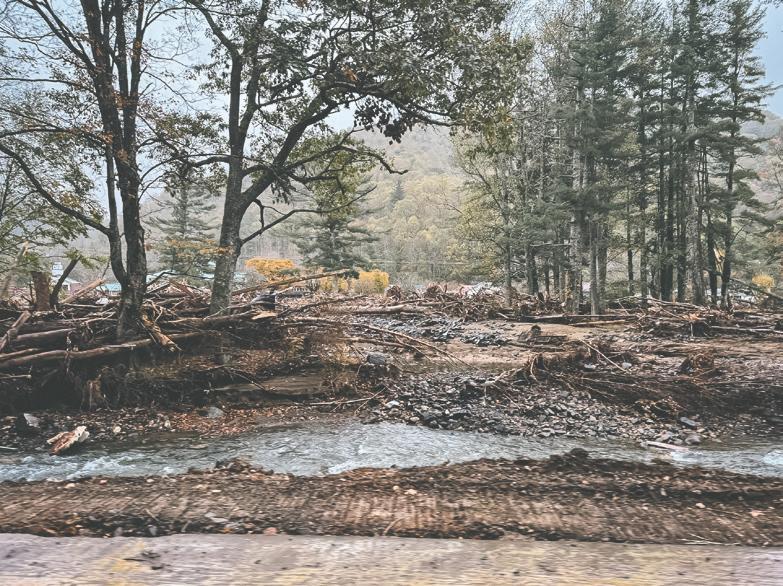
rivers overflowed, and the winds howled through ridges and valleys.
Flooding began quickly. Within hours, roads that had stood for decades were under water. In low-lying areas, homes near rivers were lifted off their foundations, carried downstream as if they were toys. Bridges crumbled under the pressure of raging water, isolating entire communities. Then the power went out. Across Avery County and much of the surrounding High Country, the lights blinked off and did not come back on for weeks. Internet service disappeared. Cellular towers failed. Radios went silent. For days, residents were plunged into a massive blackout, with no way to call for help, no way to check on loved ones, no way even to know the scope of what was happening.
The storm’s fury brought not just water but earth. Mudslides ripped down mountainsides, toppling trees, tearing through roads, and crushing homes. Entire structures slid with the mud, leaving little trace of where families had lived. As rivers swelled, so too did the human toll. Just as houses and bridges were washed away, so were people, swept downstream before they could escape. The silence compounded the horror; with communications severed, most residents had no idea how widespread the devastation was. They sheltered in place, unaware that their neighbors, perhaps only a holler away, were enduring the same nightmare. When the rain finally eased, Avery County officials began the
grim task of assessing damage. Crews left the EOC to survey what they could reach. It was immediately clear that this was unlike anything the county had faced in living memory. Entire stretches of road had disappeared. Power lines dangled or were gone altogether. Homes and businesses were gutted or destroyed. Most sobering of all, lives had been lost, and more were missing. Help was called in, though getting word out required extraordinary effort. National Guard units were mobilized. A specialized incident management team from Pennsylvania was dispatched, bringing the Pennsylvania Incident Management Team and the Pennsylvania Helicopter Aquatic Rescue Team, known as PA-HART. They brought expertise in swiftwater and aerial rescues, skills desperately needed in a county where rising rivers had cut off dozens of families.
But alongside the official response, rumors began to swirl. In the confusion of no communication, misinformation spread rapidly. Stories of mobile morgues being stationed in Avery County circulated, stoking panic. County officials, already grappling with the logistics of rescue and recovery, found themselves also needing to quell rumors, provide clarity, and keep citizens calm amid chaos.
What happened next, however, showed the true character of the High Country. Within 24 hours of the storm’s passage, Avery County’s citizens took action. Emergency personnel worked around the clock, but they were far from alone. Ordinary residents jumped into action
without hesitation. Neighbors checked on neighbors. Farmers, loggers and construction crews brought chainsaws and heavy machinery to begin clearing roads. Men and women took to the back roads and ridgelines, opening paths not just for themselves but for first responders who needed to reach stranded families.
Schools became lifelines, with staff going door-to-door to check on students and their families. Communities opened makeshift shelters, preparing hot meals and delivering them to those who could not travel. With roads impassable, citizens used side-by-sides, four-wheelers, dirt bikes, and even horseback to deliver food, water, generators, and medications. These were not acts of heroism for recognition, they were acts of survival, and they became the rhythm of life in Avery County during those first terrible days. At the 48-hour mark, communication slowly returned. Air support arrived, with National Guard helicopters delivering food, water and medical supplies. But official aid was not alone. Private citizens with contacts in aviation began organizing their own relief flights. Small helicopters and airplanes from outside the region landed on makeshift strips, bringing donations of essentials. The outpouring grew as the world finally saw how bad things were. News crews, finally able to reach the mountains, reported on the scale of devastation. The response was immediate: donations poured in, and volunteer groups across the country began mobilizing.
Organizations such as Samaritan’s Purse arrived to help shovel mud from flooded homes, while local volunteers worked side by side with them. Church groups, nonprofits, and individuals from outside the region traveled to Avery County to clear debris, rebuild structures, and offer whatever assistance they could. For every bridge washed away, dozens of human bridges formed, people linking hands, tools, and hearts to rebuild what could be salvaged.
With power out and floodwaters cutting off highways, every grocery store in Avery County was forced to shut its doors, leaving no access to food or necessities through normal means. Refrigerated goods spoiled quickly, shelves went dark, and supply trucks could not get in.
This made the deliveries and donations from neighbors, churches, and outside groups absolutely vital. Without those meals cooked in community kitchens, the generators hauled in on trailers, or the cases of water brought up winding mountain roads, many families would not have had the essentials to make it through those first days.
In the same tune, to add insult to injury, October brought with it an early chill and the first snow of the season, making heat sources that were donated a lifeline.
Still, the damage was beyond comprehension. Every corner of Avery County bore scars. No
community was untouched. Some losses were physical, but others were personal and devastating. Six Avery County residents lost their lives: Billy Joe Calloway, David Allen Carver, Melissa Sue Quinn, Robert “Butch” Ross, Cherlene Wilbur, and Russell Dale Wilbur. One, Kimberly Ashby, remains missing.
The tragedy brought national attention. Government leaders who rarely ventured into the High Country made their way to Avery County to see the destruction firsthand. National news outlets broadcast the images of washed-out roads and destroyed homes. Celebrities lent their voices, with country music stars Luke Combs and Eric Church organizing the “Concert for the Carolinas,” raising funds for recovery. That event sparked others, including “Music for the Mountains,” which continued to channel resources into the region. The eyes of the nation turned, if briefly, to Avery County.
But recovery has not been swift. A year later, many families are still rebuilding homes and businesses. Bridges remain under repair. Some residents remain displaced. To provide ongoing support, groups like the Avery County Long Term Recovery Group were formed, bringing together local nonprofits such as Volunteer Avery and Feeding Avery Families. These organizations continue to work tirelessly, coordinating aid, managing donations, and helping those who remain in crisis long after national headlines have moved on.
This week, as the county marks the first anniversary of Hurricane Helene, memorials and community events are being held to honor those lost and to reflect on the journey since. It is a moment of mourning but also of remembrance, not just of tragedy, but of resilience.
Helene was a storm that exposed vulnerabilities. It revealed how quickly communications can fail, how fragile infrastructure can be, and how swiftly nature can upend lives. But it also revealed something more profound: the unwavering strength of community. In those days without light, when the county was cut off from the world, Avery’s people did not wait to be saved. They became the saviors of one another. Neighbors risked everything for neighbors. Strangers shared what little they had. Ordinary people performed extraordinary acts.
The scars of Helene remain. They are in the broken roads still under repair, in the homes not yet rebuilt, in the grief of families who lost loved ones. But they are also in the memory of how a county stood together in the face of devastation. One year later, Avery County is still recovering. Yet it is also standing taller, shaped not only by loss but by the profound reminder that in its darkest hour, it found its greatest strength.
One year after Hurricane Helene, road and bridge repairs continue
Many roads and bridges in the High Country were severely damaged or destroyed when Hurricane Helene swept through Western North Carolina. The storm damaged nearly 9,400 sites, resulting in the closure of 1,400 state-maintained roads and damaged 818 state-maintained bridges. Even a year later, several primary and secondary roads are still not fully operational across Western North Carolina despite substantial progress made, according to the North Carolina Department of Transportation.
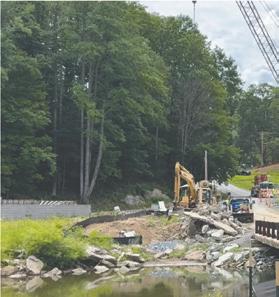
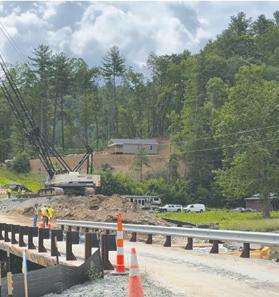


“Responding to Hurricane Helene has been our top priority since it ripped through Western North Carolina last year,” the NCDOT said in a statement. “From day one, our crews put aside their own problems to reconnect communities and restore access to local economies as quickly as possible.”
According to data from the NCDOT, a total of 318 road closures were initially reported across Division 11 following the hurricane.
Of those closures, all but six have reopened, and the remaining closures — which have detours — are due to washed out bridges.
Those six are:
The trio of Watauga, Ashe and Avery counties are a part of Division 11, which also includes Alleghany, Caldwell, Surry, Wilkes and Yadkin counties.
Dale Adams Road due to bridge #940095 being washed out (Watauga)
Circle Drive West due to bridge 940280 being washed out (Watauga)
Hopewell Church Road due to damage to bridge #940187 (Watauga)
Castle Ford Road near the intersection of River Road due to bridge #940089 being washed out (Watauga)
Big Windfall Road at mile marker 0.2 due to slope failure worsening (Ashe)
Willie Brown Road just east of the Smithey Road intersection due to bridge #040121 being washed out (Ashe)
Thirty-nine bridges were destroyed by Helene in Division 11, but as of Sept. 19, 15 have been replaced, and construction and design work continue on the remaining bridges. The NCDOT was awarded an emergency express design-build contract to Blythe Development LLC earlier this year to replace box culverts on N.C. 105 and N.C. 184. They expect construction to begin on the N.C. 105 culvert this fall, while construction on the N.C. 184 culvert should begin next year.
“A year after the storm, we remain inspired by the strength of the community to withstand and overcome Helene,” the NCDOT said in a statement. “Our response to this storm could not have been this successful without support from our families,

Heroes of Faith
Communities, churches and neighbors who carried Avery through Hurricane Helene
CHRISTIAN GARDNER
christian.gardner@averyjournal.com
When Hurricane Helene swept through Avery County, it left behind more than washed-out roads and broken homes; it left a void that only people could fill. The destruction was immediate and overwhelming, but the response was even greater. From first responders and linemen working around the clock, to churches opening their doors, to neighbors grabbing chainsaws, shovels, and side-by-sides, every corner of the county rose to meet the moment. It was a community effort born out of necessity, faith, and compassion, proving that in Avery County, no one stands alone in times of crisis.
Paul Buchanan, director of Avery County Emergency Management, reflected on the unprecedented scale of the emergency.
“The emergency response to Helene was nothing short of extraordinary. Our Avery County First Responders (fire, rescue, law enforcement, and county/city staff) went above and beyond to save lives, restore hope, and rebuild communities. Their selfless commitment made a difference when it mattered most.”
Fire departments became distribution centers. Rescue squads turned their bays into staging grounds for supplies. Law enforcement and county staff coordinated around the clock. Power crews worked in treacherous conditions to restore electricity, and linemen from across the region left their own families to bring light back to the mountains. Their work was dangerous, exhausting, and often thankless, but it helped piece together a county left in the dark. Beyond the uniforms, Avery’s churches and faith-filled communities quickly mobilized. From small congregations to larger fellowships, sanctuaries became shelters and kitchens. Meals were prepared and delivered. Clothes, blankets, and hygiene supplies were gathered and distributed. More importantly, churches became places of hope, where people could cry, pray, and be reminded that they were not alone. Jonathan Sheppard of Elk Park Christian Church described it, saying, “I think the way our churches and communities came together after Helene really showed what the body of Christ can be when it’s unified. It wasn’t about denominations or individual names; it was about meeting needs, offering hope, and standing shoulder to shoulder for our neighbors. That kind of unity didn’t just bring relief in the moment; it gave people strength to keep moving forward.” That spirit of unity wasn’t limited to
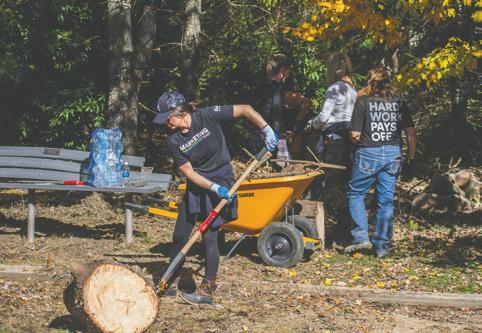
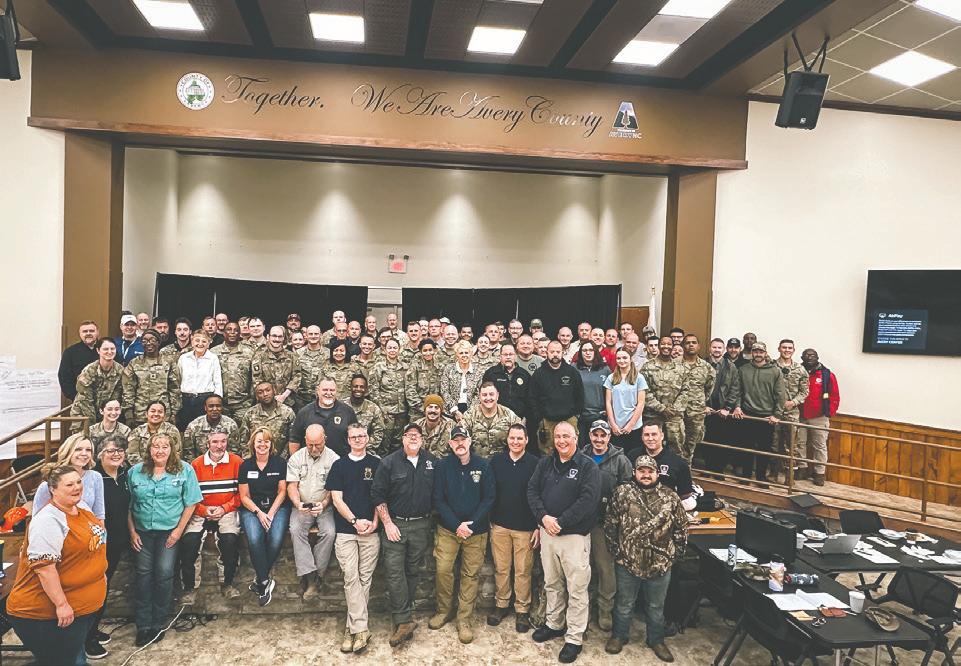
Inside the operation: How Avery’s EOC carried the county through Helene
CHRISTIAN GARDNER
christian.gardner@averyjournal.com
churches. Entire communities devised plans of action. In Spear, neighbors mapped out a contingency system to check every address in their community, ensuring no one was overlooked. They delivered meals, hauled water, and carried supplies door-to-door until the roads were safe again. In Elk Park, residents leaned on one another as churches and town leaders created staging areas for donations. Banner Elk residents gathered in their downtown, where civic groups and businesses pitched in to house volunteers, feed families, and clear debris. All across the county, fire stations filled with volunteers, doubled as supply hubs, giving residents a central place to find what they needed and providing a lifeline of stability amid the chaos.
Nonprofit organizations became the foundation of the recovery effort. From immediate relief to the long months of rebuilding that followed, groups stepped in with resources and manpower to bridge the gap where the government couldn’t. Volunteer Avery, Feeding Avery Families, Samaritan’s Purse, and many others deployed workers and volunteers to dig out homes, repair bridges, and meet practical needs.
“Nonprofits have been the backbone of recovery. From building or repairing homes, bridges, and so many other needs, nonprofit organizations are on the forefront,” said Ruth Shirley of Volunteer Avery. Together, these groups, first responders, churches, nonprofits, and everyday people, formed the county’s safety net. But perhaps the most remarkable part of Helene’s aftermath was that help came from every corner. Men and women with chainsaws cleared blocked roads. Farmers with tractors pulled vehicles from the mud and cleared roads. Neighbors on four-wheelers and side-by-sides carried medicine, food, and even generators. In truth, everyone who picked up a saw, a shovel, or simply checked on a neighbor played a vital role in Avery’s survival and recovery.
County Manager Phillip Barrier may have summed it up best, stating, “Everyone in this county was extraordinary. These people kept hope alive even in the worst of times.
Together they pulled us through it, together we are Avery.”
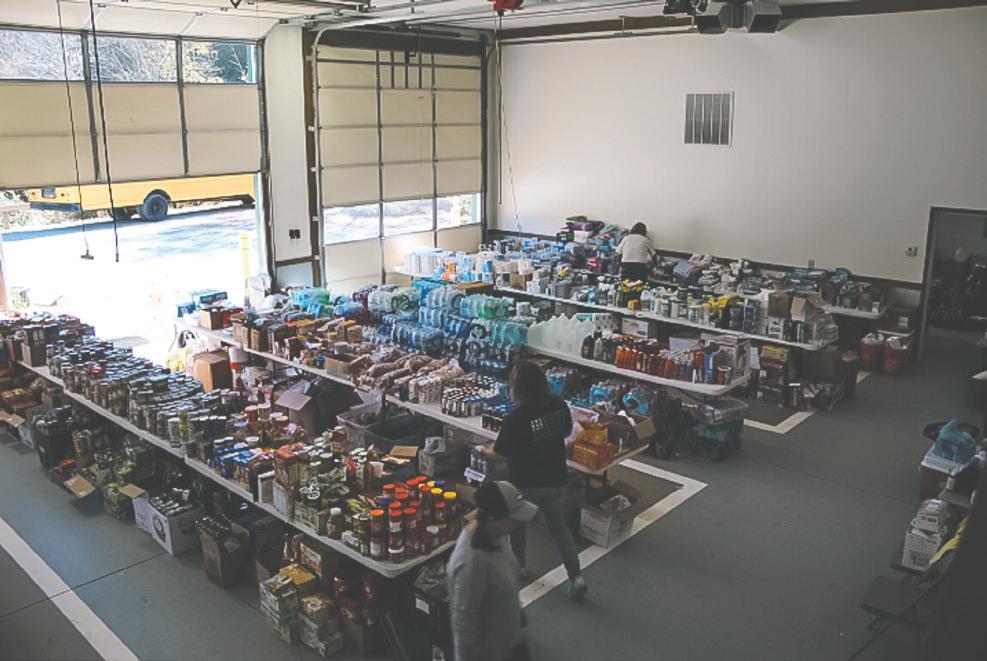
neighbors, contractors, state and federal partners, other NCDOT divisions and even other states.”
Other ongoing projects include efforts to replace a bridge over the South
Fork New River on Castle Ford Road near River Road. That construction is expected to be finished in the spring. Smith-Rowe, LLC, of Mount Airy, was awarded the $2.4 million contract to replace the bridge. The NCDOT also
stated that planning is underway to replace the bridge on Avery High School Road in Newland next summer to minimize impacts to local school traffic.
Temporary repairs were finished shortly after the storm to restore the
In the final days of September last year, as Hurricane Helene crept closer to the North Carolina mountains, Avery County officials knew the storm would be different. Forecasts warned of torrential rain, high winds, and the very real possibility of catastrophic flooding. Just days before the storm hit, the Avery Community Building in Newland was transformed into an Emergency Operations Center.
In this temporary war room, fire, EMS, law enforcement, and county staff would coordinate the county’s survival.
When Helene arrived in the early morning hours of Sept. 27, those preparations were tested in ways no one could have fully imagined. By the time the storm subsided, the Avery Community Building had become the nerve center of the entire county. Its massive main room was filled wall-to-wall with people: first responders, the sheriff’s office, county officials, dispatchers, the National Guard, FEMA representatives, Army personnel, and even an Incident Management Team from Pennsylvania. Every table was stacked with radios, maps, and laptops. The building that just days before had hosted community events was now the place where Avery County fought to hold itself together.
Inside, every department had a role. Fire and rescue agencies tracked calls from across the county, dispatching crews to pull people from homes and vehicles and respond to mudslides and fires sparked by downed power lines. EMS coordinated urgent medical evacuations, including patients who needed dialysis or oxygen, and in one case, a newborn and its mother, who were carried out to an ambulance after volunteers used an excavator to push aside fallen trees. The sheriff’s office and law enforcement fielded reports of missing persons, maintained order in areas where homes had been swept away, and helped with evacuations. County staff worked with Pennsylvania’s disaster team and others to log requests for food, water, fuel, and shelter and orchestrate search teams. Dispatchers and even the counties ‘ PIOs became lifelines, relaying latitudes and longitudes of stranded families to helicopter pilots who could drop supplies when no road access existed, as well as orchestrating videos and informational graphics to get to those very few that did have power/signal.
The National Guard and Army units deployed with heavy equipment and manpower, delivering bulk supplies, clearing routes, and establishing temporary infrastructure. County Agriculture Extension staff and state emergency management staff coordinated incoming outside resources, from helicopters to medical teams, and funneled them to the right places and helped cook meals.
From the moment the storm cleared, the EOC became Avery County’s brain. Food, water, and medicine requests were logged and assigned. Rescue operations were mapped out with grease pens on laminated charts, sometimes adjusting on the fly as crews learned of bridges that collapsed or roads that gave way. Helicopter crews like BRIM Aviation landed, reloaded, and lifted off again dozens of times a day with supplies or personnel. Farmers’ pleas for hay
connection between N.C. 181 and N.C. 194.
“The repairs and replacements on those roads will improve their resilience to future flood events,” said the NCDOT. “Helene helped us modernize our response to disasters.
to feed livestock were added to the list, and the helicopters even managed to deliver bales to isolated fields. Nothing about the operation was easy. With cell towers down and the internet cut off, most communication was by radio or handwritten notes. Rumors spread across the county, talk of mobile morgues or hundreds dead, and officials inside the EOC had to fight misinformation even as they battled real emergencies. Sleep was scarce; many spent days at a time inside the building, most of their meals coming from donated sandwiches, soup pots brought in by churches, or MREs from the Guard. “It was scary and exciting,” recalled Jerry Moody, Avery County’s agricultural extension director, who spent many days and nights at the EOC. “During the storm, we’d hear calls coming in, and we never knew whether those people got help because crews couldn’t get out in parts of the county, but it was exciting because we were making positive impacts in people’s lives. It was extremely exhausting. I didn’t realize how exhausting until someone would come up to you and say, ‘Hey, you need to go lay down.’ It was a very stressful situation, but when you’re able to help people, it’s a really good feeling. It lasted forever; we helped people there at the EOC all the way until February. To quote Charles Dickens, it was the best of times but the worst of times. Something I don’t ever want to experience again.”
County Manager Phillip Barrier echoed that balance of hardship and hope. “It started out a very dark time, but help started coming in and you felt hope and knew you were meeting needs. We saw miracles happen. People coming with truckloads of supplies, incident command, and all the other support came, and there was hope. We knew together we’d get through it.”
Exhaustion was everywhere, but so was determination. First responders walked in soaked and muddy, dropped reports of rescues, then turned right back around to head out again. Volunteers drifted in and out of the EOC, carrying supplies or taking assignments to deliver fuel and generators by four-wheeler. Every corner of the room was alive with noise: radios crackling, laptops pinging, people shouting coordinates and updates over the din. Despite the chaos, the system worked. The EOC did more than coordinate; it held Avery County together when the outside world had no idea how bad things were. For days, until communications improved and air support fully arrived, the Community Building was the only organized lifeline for thousands of people stranded across the mountains. The lessons of those days are still being processed, but one truth is clear: without the EOC, Avery County would have faced even greater tragedy. It was the brain and the heart of the response, where firemen, deputies, soldiers, aid workers, and volunteers became one team, united by the singular mission of saving lives. One year later, the Avery Community Building stands as more than a local gathering space. For those who lived through Helene, it is remembered as the place where a county under siege came together, worked without rest, and proved that even in the face of devastation, organization and unity could prevail.
We learned how to overcome extended power outages, communication challenges and scarce resources. We’ve embraced new technology to prepare, plan and respond to disaster when they strike. “We are all neighbors
helping neighbors. Our work will continue until every state-maintained road and bridge Helene damaged has reopened.” To view all of the current and previous road closures due to Hurricane Helene, visit tinyurl. com/7xtmjv3u.
New poetry book reflects on Hurricane Helene
GIADA EHRESMAN
On Sept. 27, one year after Hurricane Helene devastated Western North Carolina, Baylee Sanders’s poetry collection Coming Home with Shouts of Joy is set to debut. This collection features raw and vulnerable poems that serve as her way of processing Helene.
Despite the upcoming release of her poetry book, Sanders said, “I am not a poet, actually.” Sanders has called Western North Carolina home for all of her life, as she grew up in Burnsville and attended Appalachian State University in Boone. She now lives in Ashe County.
Helene was one of the most challenging experiences of her life, like many others who live in the WNC region. While her immediate area did not suffer much physical damage, her family’s experience was far different.
“My dad is a cop for the Mitchell County Sheriff’s Department, and he called me the morning of the storm, and he was like, ‘Just want to check on you, are you okay? Is everything okay up there?’ He told me about how, initially, they had been clearing the roads and just trying to keep the roads clear for emergency services,” Sanders said.
During that phone call, her father shared a moment that left a deep impression

on her.
“And he takes a step back, and the moment he took that step back, a tree fell right where he had just stood,” said Sanders. “So the Lord saved him.”
For three days, she had no cell service and no way of knowing if her father was safe.
“That was the longest three days of my life,” Sanders admits.
Having witnessed the widespread destruction and left feeling uncertain, Sanders was left with a lasting emotional effect that weighed heavily on her.
It wasn’t until February, during bad ice storms and flickering power, that the memories of Helene came back fully.
“Everything was terrible,
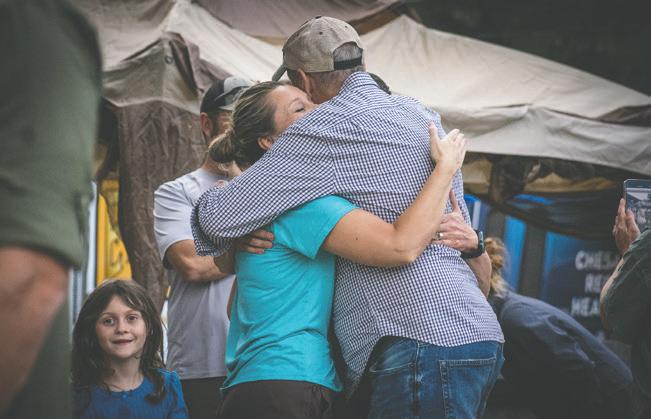
Avery to mark Hurricane Helene milestone with multiple events
CHRISTIAN GARDNER
christian.gardner@averyjournal.com
On Saturday, Sept. 27, Avery County will pause to reflect on the one-year anniversary of Hurricane Helene with a series of community events across the region. From solemn remembrance to uplifting fellowship, the day will bring together residents to honor those lost, recognize the heroes of the storm, and celebrate the strength that carried the county through one of the most devastating chapters in its history. The day begins in Newland at 10 a.m., where Avery County government will host its official Day of Remembrance & Honor at Avery Square. This gathering will serve as the county’s central ceremony, recognizing the lives lost during Helene and the countless citizens, responders and volunteers who rose to the occasion in its aftermath. The event is described as a chance for the community to come together, reflect, pay tribute and celebrate the resilience that carried the community forward.
From there, the focus shifts just down the road to Big Mike’s Campground in Newland, where the Helene Rising Festival will run from 11 a.m. until 8 p.m. Billed as a celebration of “the community’s ability to overcome,” the festival will feature food trucks, vendors, games and prizes, along with a full lineup of live music. Performers include 30 Ought 6, Jason Burleson, Tommy Carver, Boone & Church, The Collective, Crossnore Jam, and many others. Local favorites like Big Mike’s Coffee, Sips Soda, Diggy Donuts, Lakeo, Pan de Vida, and churros vendors will be on site serving throughout the day. Guest speakers are also planned, adding a reflective tone to what is otherwise a lively community gathering. Entry is free and open to all.
The day closes in Banner Elk from 2 to 4 p.m. with Banner Elk Remembers, hosted on the lawn in front of the Historic Banner Elk School. This observance is being coordinated by the Banner Elk Tourism Development Authority and is intended as both a reunion and a remembrance. Organizers are encouraging neighbors to come together to recognize the efforts of first responders, town and county leaders, caregivers, and volunteers who stepped up during and after the storm. The event will also spotlight the town’s continuing recovery, emphasizing the importance of community support. Food and live music will be provided, and residents are encouraged to shake hands, share stories, and remember the sense of unity that helped carry them through.
From morning until evening, the county will gather not only to mourn the tragedy of the storm but also to reaffirm the strength and spirit that define the High Country.
and I was just having a really hard time. And so one night, after a really bad day, I’m praying and I cried out to God, and I was like, ‘I need you to do something, I cannot live this way,’” Sanders said, explaining that this was the first time she put pen to paper and wrote in her journal a poem.
“I hated poetry in high school,” Sanders shared.
“When I wrote that poem, it was just kind of me reflecting on the hurricane.”
She said she felt it was strange, but she had more to say. In the span of an hour, that night, she wrote four poems.
Sanders said the next morning was when she decided she was going to write a collection of poetry in two parts: her story

and what she describes as “God’s story.”
“In part one, I chronologically told the story of the hurricane and what I went through. It’s dark, and I just hash out all my feelings and all the things, and it’s really hard. But then God was like, when you get to part two, let me
tell my story. Like, ask me where I was during all this, you know the ageold question, why does the good Lord let bad things happen?” she explained. Over the next four weeks, Sanders wrote more than 60 poems. Through writing, Sanders said she found healing.
“I felt very strongly that I couldn’t sit on it, and I wanted other people who lived through this to be able to read those words of healing, too,” said Sanders. Her collection, currently available for preorder on Amazon, is deeply personal but also intended for others who lived through the hardships of Helene. She hopes readers can draw strength from her collection.
“The biggest thing for me is that my hometown will never look the same. Like a year later, Yancey County, there’s still debris on the side of the road. There’s still roads that are out.”
She hopes her community will find encouragement and peace for the long road of recovery.
“I hope that something that people can hold on to, something to remind them, is that it will be okay. We can rebuild, and we will come out on the other side stronger.”
Sanders credits her church community with surrounding her with support during this time as well as her family who supported her self-publishing Coming Home with Shouts of Joy. By sharing her poetry, she hopes to encourage hopeful and positive movement forward for all who endured Hurricane Helene.
Storm Shadows: How Helene impacted Avery County’s youth
CHRISTIAN GARDNER christian.gardner@averyjournal.com
When Hurricane Helene ripped through Avery County, its immediate destruction was clear as it washed out bridges, homes were swept away, and roads were destroyed. But some of its most lasting effects are far less visible, carried quietly in the hearts and minds of the county’s youngest residents. For children and teenagers, Helene was not just a natural disaster. It was a moment that disrupted their sense of safety, stability, and even their path to learning.
For many young people, the trauma began the night of the storm. Some watched floodwaters creep up to their doorsteps, uncertain if their homes would stand. Others witnessed houses collapse or sweep away entirely. Families huddled together in the dark, powerless as the storm severed communications and left communities cut off for days.
In the aftermath, displacement added another layer of stress.
Children whose homes were damaged or destroyed often found themselves living with relatives, in temporary housing, or even in shelters. What should have been a return to routine, school, friends, and familiar spaces, was disrupted by the uncertainty of where they would sleep or how their families would rebuild. For those still in temporary housing a year later, that uncertainty continues to weigh heavily.
The storm also dealt a direct blow to education. Schools became emergency shelters or supply distribution centers, delaying the start of classes. Roads and bridges leading to schools were washed out, keeping some students home for weeks. Even after classes resumed, attendance remained uneven as families struggled with transportation or ongoing recovery needs.
The cumulative effect was significant learning loss, particularly for younger students or those already facing academic challenges. Teachers were forced to balance classroom instruction with the emotional needs of students who were still processing trauma.
In Avery County Schools, those challenges remain evident.
“Students at Freedom Trail Elementary continue to feel the emotional weight of Hurricane Helene. Many are still struggling with anxiety and stress tied to the storms and the disruptions they brought. For some, the instability and loss during and after


Helene have created ongoing worries about safety, security, and the future,” said Principal Emily Dellinger.
She added that staff have seen students who need “more reassurance, patience, and emotional support” as they continue to process what they experienced.
Dellinger also emphasized how the school community has stepped up: “The sense of community has been critical; our house system, peer support, and caring adult relationships have become safe anchors for students navigating lingering storm-related trauma.”
“The academic impact has been equally significant. Extended closures and missed instructional days created gaps in learning that are still being felt across grade levels,” Emily explained.
She also explained that while teachers have worked diligently to recover instructional time, the disruption slowed pacing and required adjustments to intervention and tutoring schedules. Students who were already at risk academically have been especially affected, as consistency and structured support are vital to their progress.
At the high school level, similar challenges have played out.
John Gage, a counselor for ninth and tenth graders at Avery High School, has seen both the hardships and strengths of his students.
“You saw some significant mental health struggles, kids displaced from their homes, moving into temporary housing, or living with the stress of losing everything. But at the same time, you saw resiliency. Students found normalcy in school, reconnected with friends who had been through the same thing, and even spent time volunteering to help
others. It showed both sides, the toll of trauma, and the strength these kids have to keep moving forward.”
Mental health has been one of the most profound and lingering areas of concern. Some children experience heightened fear whenever heavy rain falls, associating storms with danger. Others struggle with sleep disruptions, flashbacks, or difficulty concentrating in school. Counselors and teachers have noted changes in behavior ranging from withdrawal and sadness to bursts of anger or anxiety. While support systems have been put in place, the sheer scale of the storm’s emotional impact has left gaps that schools and counselors are still working to fill.
Yet amid the challenges, resilience is also part of the story.
Many young people have shown remarkable adaptability, helping families clean up debris, supporting siblings, or volunteering with community efforts. Schools and nonprofits have worked hard to provide safe spaces for students, whether through counseling programs, after-school activities, or simple acts of kindness that remind children they are not alone.
One year later, the effects of Helene on Avery County’s youth are still unfolding. For some, scars will fade with time and healing. For others, the memories may shape their lives for years to come. What is clear is that the storm changed childhood in Avery County. It interrupted learning, upended homes, and replaced innocence with memories of loss and survival. Addressing these impacts will take patience, compassion, and ongoing support from families, schools, and the community at large.
Where are they now one year after Hurricane Helene?
CHRISTIAN GARDNER christian.gardner@averyjournal.com
One year after Hurricane Helene tore through Avery County, the images of destruction remain etched in memory: washed-out bridges, homes swept from foundations, businesses shuttered in the dark. Yet the story of Avery County has always been about more than loss. It has been about resilience, about neighbors helping neighbors, and about the quiet, relentless work of nonprofits that continue to shoulder much of the recovery. In the first days after Helene, Avery’s communities pulled together in remarkable ways. Neighbors grabbed chainsaws and cleared roads. Schools checked on students door-todoor. Churches cooked meals and delivered them by four-wheeler or horseback. That spirit of unity carried families through the first weeks. But recovery has proven to be a marathon, not a sprint.
Twelve months later, the county’s story is one of both progress and ongoing struggle. Some businesses that reopened quickly have not only survived but managed to thrive in the year since, even after a major loss in revenue of loosing a full autumn season in the Blue Ridge mountains. Others, overwhelmed by damage or financial strain, made the difficult decision to close their doors. Families, too, have had different journeys. Some rebuilt or repaired their homes, drawing on savings, insurance, or volunteer help. Others remain in transition, working with organizations like the Appalachia Service Project, the Avery County Long Term Recovery Group, and Chief Cares to secure new homes after losing everything. For a handful, relocation proved the only option; they moved on, leaving behind both heartbreak and history.
The nonprofits have been the backbone of this long recovery.
Feeding Avery Families continues to play a critical role, ensuring that anyone in need has food on the table. That includes not just those who were in crisis before the storm, but also families who lost everything when Helene hit and are still struggling to get back on their feet. Bridges for Avery, another grassroots effort, remains hard at work helping restore access to homes cut off when private bridges washed away. While some families now have permanent crossings again, others still rely on makeshift footbridges, often built by volunteers in those frantic early days after the storm. For these residents, simply getting home means carrying groceries, fuel, and supplies across planks of wood stretched over creeks, waiting for the day when a proper bridge is finally built. For some, however, a new bridge may simply be a “railcar bridge” that was made from a retired
Heart of the High Country proceeds continue to make local impact
A year ago, Mountain Times Publications’ three leading newspapers were covering the devastation that Hurricane Helene brought to Western North Carolina.
When recovery efforts were well underway and the immediate needs were being addressed, staff began to brainstorm ways to not only tell the many stories of the community pulling together and helping one another, but also how to give back to help with relief efforts. That became Heart of the High Country. Released at the end of December, the 120-page magazine shared more than 50 stories of firsthand accounts of recovery efforts, acts of kindness and community strength in the aftermath of the storm. A portion of advertising proceeds and 100% of its sales were earmarked to support relief and community organizations.
So far, donations have been made to W.A.M.Y Community Action, Feeding Avery Families, and — most recently — Samaritan’s Purse.
“We are proud that we can continue to donate to Hurricane Helene relief efforts in our community,” said Mountain Times Publications Executive Editor Moss Brennan. “Every dollar we have donated so far is going back to the communities we cover as they continue to work to help people recover from the devastating impacts of Hurricane Helene, even a year later.”
More donations will be announced in the coming

MTP Executive Editor Moss Brennan presented a donation to WAMY, made possible through a portion of the advertising proceeds from Heart of the High Country. Pictured front row left to right: Moss Brennan, Executive Editor, Allison Jennings, Director of Development, Taylor Fines, Finance Assistant, Kylie Luxton, Volunteer. Back row left to right: Seth Morre, Intake Specialist, Tyler Holden, Housing Rehabilitation Specialist, Corey Babay, Finance Director, So a de Camera, Hurricane Relief Specialist, Brittany Luxton, Executive Director, Sarah Freer-Balduf, Director of Administration.

Journal-Times Editor Jamie Shell and Mountain Times Publications Executive Editor Moss Brennan visit Feeding Avery Families on August 22 to present a $5,000 check to area nonpro t Feeding Avery Families Executive Director Bonnie Clark and sta members including Vanessa Phillips and Cindy Reed.
weeks for continued relief efforts.
To pick up a physical copy of the magazine, visit the Watauga Democrat (584 State Farm Rd., Boone), the Avery Journal
Times (428 Pineola Street, Newland) or the Ashe Post and Times (7 East Main St, West Jefferson).
To view the magazine online, visit tinyurl. com/3y2c5wav.
Wine To Water deepens commitment to WNC recovery after Hurricane Helene
400,000 gallons of clean drinking water
When Hurricane Helene swept across Western North Carolina in September 2024, it unleashed one of the most catastrophic inland flooding events in the region’s history. Homes were lost, wells were contaminated, and thousands were left without access to clean water.
Within 48 hours, Wine To Water (WTW), an international nonprofit headquartered in Boone, mobilized a rapid response, delivering safe water, vital supplies, and hope to the hardest-hit communities.
Over the past year, Wine To Water and more than 1,300 dedicated volunteers have:
Provided free water testing in 23 counties, completing 920+ water quality tests to ensure private wells and spring boxes remain safe
Distributed over
Delivered 1.2 million pounds of emergency supplies
Continued providing filters, hygiene kits, and bulk water to families still in need
While WTW still offers free water quality testing, recovery efforts have transitioned to water-system repairs and disinfections to ensure safe, long-term access to drinking water.
“Western North Carolina is our home, and our recovery from Hurricane Helene has shown just how strong and united our community is,” said Jeremy Kilday, U.S. Program Director at WTW.
“Over the past year, we’ve come a long way — working side by side with families, community organizations, and local agencies to restore safe water access. But our work doesn’t end here.
We’re committed to continuing this journey,
railroad car, still quite literally “bridging the gap” for those in need.
The Avery County Long Term Recovery Group continues to coordinate cases, pairing families with nonprofits and faith-based partners. These groups bring teams of volunteers and skilled labor to rebuild homes, clear debris, and restore hope. Appalachia Service Project, known for its work across Appalachia, has been a steady presence, sending in groups to repair and construct houses for those with nowhere else to turn.
Chief Cares, the philanthropic arm of country music star Eric Church, has also stepped in to support homebuilding efforts, partnering with local agencies to provide permanent solutions for families displaced by Helene. Most recently, announcing homes are being built at the new Blue Haven property in Newland, which will house 40-some families.
What has become clear over the past year is that resilience was only the beginning. The first wave of help, the neighbors with chainsaws and the helicopters with food drops, was vital. But the quiet grind of recovery has been sustained by nonprofits that refuse to walk away once the headlines faded. They continue to work side by side with Avery’s families, bridging the gap between immediate survival and long-term stability. Avery County’s story after Helene is not finished. Some families now live in newly rebuilt homes, while others still cross footbridges or wait on case managers to find solutions. Businesses have reopened or disappeared, and lives have been remade in ways both hopeful and heartbreaking. But the constant thread through it all is the determination to recover and the network of nonprofits, volunteers, and community members who continue to make that possible.
Eye of the storm
Communities still rebuilding and recovering after Hurricane Helene
A year ago, Hurricane Helene rampaged through Florida, Georgia, the Carolinas and Tennessee with high winds, biblical rains and destructive storm surges and floods that left 252 people dead and caused an estimated $79 billion in damage.
A few weeks later, Hurricane Milton slammed Florida and Georgia, killing 46 people and causing another $34 billion in damage.
Helene brought torrential rains and deadly floods to areas of the Carolinas and Appalachia, with warmer ocean water fueling larger and more destructive hurricanes.
Some areas saw historic amounts of rain and major power outages from Helene’s monstrous storm clouds.
Parts of Transylvania and Yancey counties in North Carolina were hit with 30 inches of rain. Greenville, South Carolina, saw 21.66 inches.
Heavy rains stretched from Florida to Ohio and Indiana, according to the National Oceanic and Atmospheric Administration (NOAA).
From Western Carolina and Appalachia to Florida’s Gulf coast and southern Georgia, communities are still healing and rebuilding from last year’s devastating hurricane season.
Those on the frontlines of the recovery efforts say progress has been made, but more work and challenges remain.
‘NEARLY EVERY STRUCTURE’
walking with our neighbors to ensure households have access to the clean, safe water they need to thrive.”
Wine To Water will host a free public commemoration event from 5 to 8 p.m. on Friday, Sept. 26, at Appalachian Mountain Brewery in Boone.
The evening will include reflections from community partners and families impacted, stories of resilience and recovery, complimentary food and drinks (with RSVP) courtesy of FiltersFast.com, live music and opportunities to get involved in ongoing recovery work To RSVP for free, visit hurricaneheleneoneyearcommemoration. eventbrite.com
To support the organization’s work in Western North Carolina, visit give.wtw.org/wnc2025.
For more information about Wine To Water, visit About Wine To Water
On Florida’s Gulf coast, Hurricane Helene brought historic storm surges and flooding to the southwestern parts of the state as well as the Big Bend and Tampa Bay areas.
Some of those same areas were hit in October by Hurricane Milton.
“We had widespread flooding during Helene, with nearly every structure in the city taking water, some as much as 5 feet. Milton tore off roofs from condos and knocked down trees and power poles, many residents were without power and water for 7 to 10 days,” said Trip Barrs, fire chief in the beach town of Treasure Island in the Tampa-St. Petersburg area. Other parts of Florida also got hit by both hurricanes.
“Helene impacted some of our coastal areas on Sept. 26 last year, and then Hurricane Milton impacted a much broader area of Lee County mere days later on Oct. 9,” said Betsy Clayton, communications director for Lee County, which includes Fort Myers.
That area of southwest Florida experienced a storm surge of more than 5 feet and 6 inches of rain in a short period from Hurricane Helene.
A few weeks later, Milton
brought winds of 120 miles per hour, a 6.8-inch storm surge in Lee County and heavy rains. Parts of Florida saw numerous tornadoes.
Lee County collected more than 627,000 cubic yards of debris from the two storms, according to a post-storm analysis.
In Treasure Island, Barrs said roughly a year later that there are “many vacant residential and commercial lots” from the storms.
“We are starting to see some rebuilding and some homes being elevated. Many businesses were not able to reopen, and others are still in temporary facilities,” he said.
Other challenges persist.
“Many residents are still not able to rebuild or repair their homes. This is due to a variety of issues: insurance, permitting, old/non-flood compliant structures. Many of our smaller, 1-story hotels will not be able to reopen,” Barrs said.
High insurance costs and sometimes delayed, disputed or denied storm claims have been causes for frustrations in Florida, in particular, as well as other states.
Barrs said some hotel rooms have started to come back online, and a beach renourishment project replacing sand lost to the storm surges is slated to start “in the coming months.”
Other communities and tourist attractions in Helene’s path have also reopened and have been marketing and advertising that to targeted audiences.
That includes Asheville, the popular arts and tourism hub in western North Carolina.
“We’re shouting it from our beautiful Blue Ridge mountaintops—the Asheville area is open for business and eagerly welcoming visitors after Hurricane Helene impacted our region in fall of 2024,” said Dodie Stephens, vice president of marketing for the Explore Asheville tourism group, earlier this summer.
The group has been advertising in regional drive markets as well as cities with flight connections to Asheville.
“Downtown Asheville was largely unimpacted by the storm last fall and many of the most iconic hikes, overlooks and attractions along the Blue Ridge Parkway are open,” she said.
The Biltmore gardens reopened in November 2024 and is hosting an exhibition featuring Egyptian pharaoh Tutankhamum through Jan. 4, 2026.
Some areas of the Appalachian Trail damaged by Hurricane Helene have been repaired or reopened. But there continues to be repair work and debris collections in other trail areas in North Carolina, Tennessee and Virginia, according to the National Park Service.
There are detour areas along the 2,200-mile trail because of storm damage and remediation.
Some Florida communities
saw backlogs and delays with permitting approval after the storms.
That prompted Treasure Island and other localities to take fresh looks at its emergency planning and response, Barrs said.
In Lee County, local officials have been reexamining their communications and social media policies on how to keep the public best informed during major storms and other emergencies.
‘HISTORIC DAMAGE’
Beyond its coastal impacts, Helene brought major flooding, downed trees and damaged homes, buildings and roadways in Georgia, the Carolinas and Tennessee.
“At one point during the storm, over 1.2 million gallons of water per second flowed over the Nolichucky Dam. In comparison, Niagara Falls’ peak daily flow is 700,000 gallons of water per second,” said Mark Nagi, regional communications officer for the Tennessee Department of Transportation. The state also removed more than 720,000 cubic yards of debris from Helene.
“This storm has caused historic damage to bridges and roadways, especially in Upper East Tennessee. TDOT anticipates hundreds of millions of dollars in damage,” Nagi said. Helene’s biblical rains and floods damaged and shut down parts of Interstate 40 near the Tennessee, North Carolina border and 49 sections of state and local roadways in the eastern part of Tennessee last year.
“Work on full restoration of I-40 in Cocke County continues,” Nagi said. “We anticipate the roadway being fully back open in Summer 2026. We have had one lane open in each direction since late October 2024.”
Forty-seven of the 49 impacted state and local roadway areas have reopened, with the two remaining areas under contract to be repaired this fall and next spring.
Tennessee surveyors inspected all 490 state-owned bridges that the storm could have damaged.
Nagi said two bridges in Greene and Washington counties were built in a faster “Progressive Design-Build” mode that allowed design and construction phases to overlap.
“Those bridges were each opened in less than 8 months. Without PDB being utilized, it would have probably taken approximately 2 to 3 years to reconnect those communities,” he said.
On Sept. 15, North Carolina Gov. Josh Stein called for an additional $13.5 billion in federal funding to help with Hurricane Helene reconstruction.
That includes $8 billion to help rebuild homes and small businesses, $2 billion for local governments financially strained by the storm and its cleanup, and $2 billion to help with reconstruction and full reopening of sections of I-40 hit by the storm.
give your Medicare, Social Security, credit card, or bank account numbers over the phone or through text or email to anyone who contacts you unexpectedly and claims to be from Medicare.
Your caller ID may show Medicare’s name or phone number, but caller ID can be faked. Hang up and call 1-800-MEDICARE (1-800-633-4227).
cards are sent automatically, for free. You will NEVER be asked to pay for your new card.
